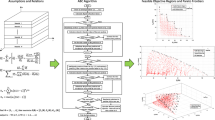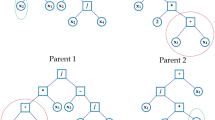Abstract
An efficient nondestructive evaluation procedure is proposed for inversely determining material constants of composite laminates using dynamic response at one point on the plate surface. Material constants of composite laminates are determined by minimizing the difference between the measured dynamic response of the actual plate and the computed response of the plate with assumed material properties. For robust and efficient function minimization, a real parameter-coded microgenetic algorithm (real-μGA) is proposed on the basis of the existing binary coded uniform microgenetic algorithm (uniform μGA). Four different crossover operators are constructed for the real-μGA. Performances of the present real-μGA and the existing uniform μGA are studied using several typical benchmark test functions and an order-3 deceptive function. The present real-μGA is then implemented as the inverse solver in the minimization process of material characterization. From hundreds of tests conducted on the benchmark functions, the order-3 deceptive function, and the material characterization problems, it is found that the real-μGA is two to five times faster in converging to the global optimum compared with the uniform μGA. Numerical examples for material characterization of composite laminates have demonstrated the robustness, efficiency, and accuracy of the proposed procedure.













Similar content being viewed by others
References
Ayorinde EO, Gibson RF (1993) Elastic constants of orthotropic composite materials using plate resonance frequencies, classical lamination theory and an optimized three-mode Rayleigh formulation. Compos Eng 3:395–407
Balasubramaniam K, Rao NS (1998) Inversion of composite material elastic constants from ultrasonic bulk wave phase velocity data using genetic algorithms. Composite B 29B:171–180
Chai JF, Wu TT (1994) Determination of anisotropic elastic constants using laser generated surface waves. J Acoust Soc Am 95(6):3232–3241
David LC (1996) Genetic algorithms and optimizing chemical oxygen-iodine lasers. Dev Theor Appl Mech 411–424
De Jong KA (1975) An analysis of the behaviour of a class of genetic adaptive systems. Doctoral Disertation, University of Michigan
Deobald LR, Gibson RF (1988) Determination of elastic constatnts of orthotropic plates by a modal analysis/Rayleigh-Ritz technique. J Sound Vibr 124:269–283
Dymek A (1992) An examination of hypercube implementation of genetic algorithms. M.S. and Report No. AFIT/GCS/ENG/92 M-02 Thesis, Air Force, Institute of Technology, Wright-Patterson Air Force Base
Eshelman LJ (1989) The CHC adaptive search algorithm: how to have safe search when engaging in nontraditional genetic recombination. In: Spatz BM (ed) Foundations of genetic algorithms. Morgan Kaufmann, San Mateo, pp 265–283
Goldberg DE (1990) Real-coded genetic algorithms, virtual alphabets, and block. Technical report no. 90001, University of Illinois
Goldberg DE, Korb B, Deb K (1989) Messy genetic algorithms: motivation, analysis, and first research. Complex Systems 3, Complex Systems Publications, pp 490–530
Hallquist JO (ed) (1998) LS_DYNA Theoretical manual. Livemore Software Technology Corporation
Holland JH (1975) Adaptation in natural and artificial systems: an introductory analysis with application to biology, control and artificial intelligence. University of Michigan Press, Ann Arbor
Janikow CZ, Michalewicz Z (1991) An experimental comparison of binary and floating-point representations in genetic algorithms. In: Proceedings of the 4th international conference on genetic algorithms, pp 31–36
Krishnakumar K (1989) Micro-genetic algorithms for stationary and non-stationary function optimization. In: SPIE: intelligent control and adaptive systems, Philadelphia, p 1196
Omitted
Man KF, Tang KS, Kwong S (1998) Genetic algorithms: concepts and designs. Springer, Berlin Heidelberg New York
Rose WR, Rokhlin SI, Adler L (1986) Evaluation of anisotropic properties of graphite composites using lamb waves. In: Thompson DO, Chimenti DE (eds) Review of progress in quantitative nondestructuve evaluation, vol 6B. Plenum, New York, p 1111
Wright AH (1991) Genetic algorithms for real parameter optimization. In: Rawlins JE (ed) Foundations of genetic algorithms. Morgan Kaufmann, San Mateo, pp 205–218
Wu T-T, Liu Y-H (1999) On the measurement of anisotropic elastic constants of fiber-reinforced composite plate using ultrasonic bulk wave and laser generated lamb wave. Ultrasonics 37:405–412
Author information
Authors and Affiliations
Corresponding author
Rights and permissions
About this article
Cite this article
Liu, G.R., Ma, H.J. & Wang, Y.C. Material characterization of composite laminates using dynamic response and real parameter-coded microgenetic algorithm. Engineering with Computers 20, 295–308 (2005). https://doi.org/10.1007/s00366-004-0298-y
Received:
Accepted:
Published:
Issue Date:
DOI: https://doi.org/10.1007/s00366-004-0298-y




